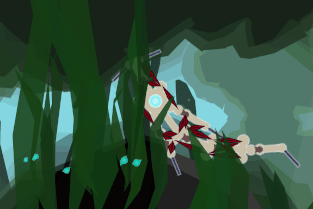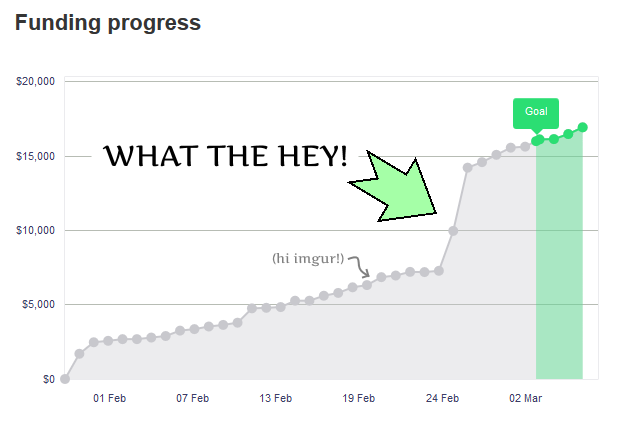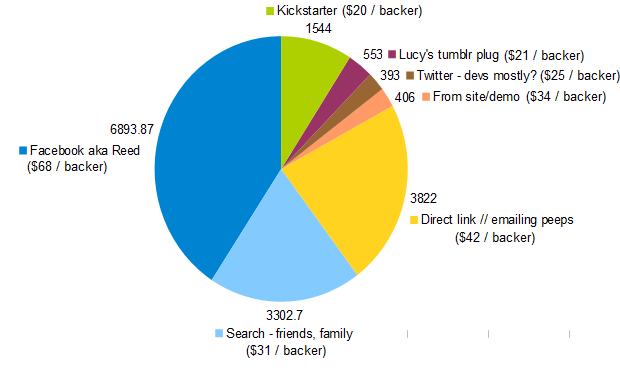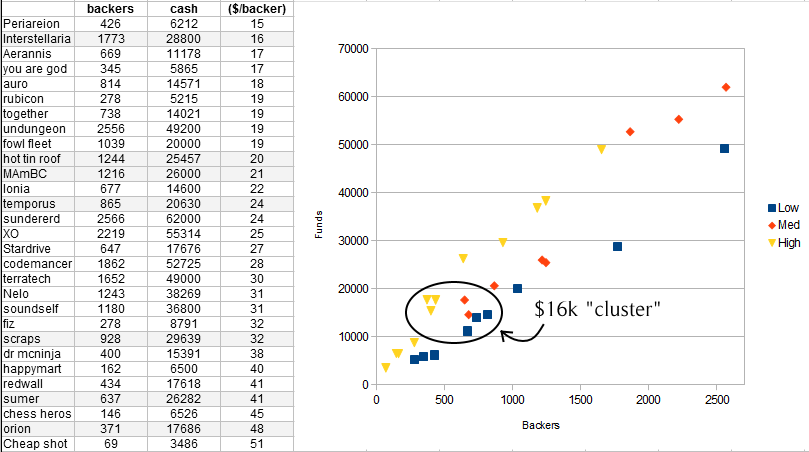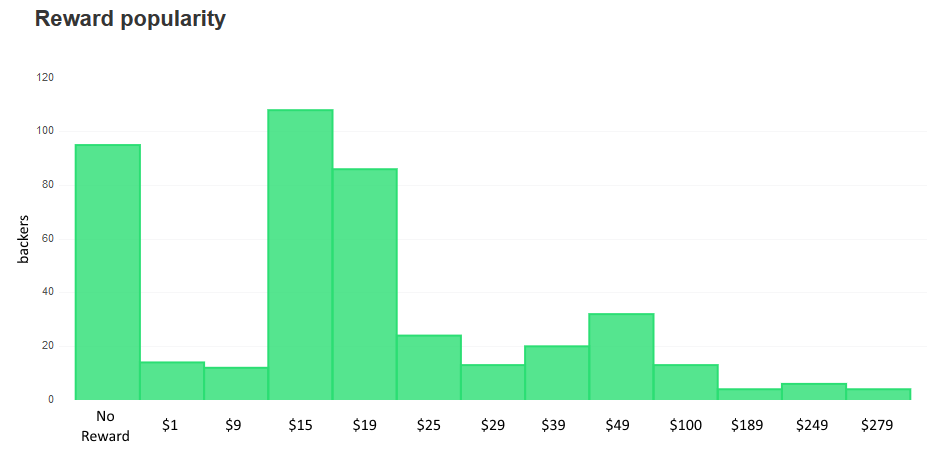Crescent Loom Kickstarter Postmortem
Hi! Quick intro: My name is Wick, I'm a neuroscientist / solo indie game dev, and I just ran my second successful Kickstarter campaign. The game is called Crescent Loom; players build creatures, weave brains, and explore an underwater ecosystem.
Common wisdom says that most of the time campaigns see a big spike at the start, have a big plateau in the middle, and another spike at the end. Crescent Loom... did not follow that pattern.
What happened? Lemme back up and give some context to what things were like right before that huge jump.
Social: My core was Facebook friends from college. I'd been talking about this for years, and had been posting a Creature of the Day every morning (despite fb's terrible gif support), so there was a handful of good friends who really helped get the word out by sharing. Even if not everyone who had seen it had backed, I think I'd gotten pretty good exposure to most of the bubble.
Press: On the other hand, I hadn't had very much success in engaging games press / other internet denizens. Sent out a bunch of press emails, heard back from nobody. Launched the Greenlight, hardly any cross-pollination. It hit the front page of Imgur, but didn't convert to a lot of backers (I'll talk about that more in a bit).
Situation: So by mid-campaign we were less than a third of the way there, and kicktraq was only projecting a final total of ~$10k. It was rough. I was being deluged with spam promising magical publicity turnarounds, and was haunted by the specter of the morally/financially/legally questionable option of emptying my savings account to push it past at the end.
Then, two things happened:
-
While emailing Kickstarter about getting the STEM tag applied to Crescent Loom, they suggested I try the new Kickstarter Live service to stream an event. I thought it would be worth a shot, but didn't have a strong idea of what kind of event to hold.
-
I found a backer through Reed who, on hearing that I was considering going broke in order to make this game, offered to match pledges up to a few hundred dollars for a single day.
I combined 'em and organized the Crescent Loom Paired Pledge Powerup Party on February 26th -- the results of which you can clearly see on the funding graph. My friends helped spread the word that there was a one-day-only opportunity to have your pledge matched, and enough people responded that the campaign had doubled by the evening. (I cannot adequately express the relief I felt. This one night basically made the campaign and probably changed the course of my life.)
Finally, a different connection from college hit the real-world fundraising ground and started getting a lot of her personal connections to pitch in, which summed up just north of $1k. I honestly don't know how she does it (though the phrase "Filipina Mafia" was thrown around...).
Who backed it?
(that .87 -- that's you, Issac. Look what you've done. Are you pleased with yourself? ARE YOU HAPPY?)
It was a campaign of friends & family (and friends of friends); random internet strangers only consisted of about a third of the backing. The crazy huge amount of time I spend on pushing out that direct link (I wish I used more reference links to know where exactly people were coming from) ended up being a disproportionately small slice of the pie.
For a while, this actually made me feel like I failed. A voice in my head says: "We made it, but it's only because I was bailed out by my community. If I had done a better job, random strangers would have flocked to it (this is totally the best way to judge your self-worth) and I wouldn't have had to rely on my loved ones.”
Which, of course, is complete bull. I'm super lucky that I've met so many amazing people who are willing and able to support something like this, but all projects depend on some specific community to make them happen. The people I connected with just happen to be mostly via real-world connections instead of purely online ones. Maybe if I had amazing art or a snappier video or a more polished pitch or done better contacting journalists, it could have pulled in more people who stumbled on it online... but you can always do better, and I should focus on the people who I did connect with.
Let's look at this Analytics traffic graph to illustrate the point: Two traffic spikes: one from getting 140,000 views on Imgur (which translated to ~500 hits to the page itself, click-through math is brutal), and another from the aforementioned paired-pledge facebook push. They're not that different in size, but the former resulted in a barely-noticeable blip, and the latter turned my life around. Getting eyes on your stuff is important, but it's more powerful to form relationships and focus on the "who" instead of "how many".
Steam Greenlight: I launched the Greenlight campaign Feb 9, mostly for advertising purposes (though you can see how well that worked). One thing the traffic from Imgur did do was make the Greenlight process mercifully swift; it passed on the 28th (kind of out of the blue, I don't think it was related to the KS success).
Setting the Funding + Stretch Goals
Before launch, I decided to crunch some number from other campaigns. It was a dirty back-of-the envelope data collection effort where I went through other game campaigns, picked out the rough funding and backer numbers of campaigns, and plugged them into a big list.I had two main takeaways:
-
The effect of having a higher average pledge / backer is can be huge. In the graph I've separated out campaigns with higher and lower pledges by color. Looking at the yellow triangle campaigns, a lot had effective high-level rewards and a compelling reason to pledge more than one would normally for a game - like Chess Heros' educational aspect or Redwall's nostolgia.
-
(note: there's a handful of ancient outliers in this list that are from before people knew how much was reasonable to pledge for a Kickstarter. It's crazy to see the increase in quality of today's campaigns compared to really old ones.)
-
-
In order to break $20k, it looks like you have to be either one-hundred-percent on top of your campaign (XO) or go viral with some kind of jaw-dropping art (UnDungeon), or both. There was a small cluster of projects closer to $16k that were high-quality but for some reason couldn't break through.
I had calculated needing a bare minimum of $20k to work on Crescent Loom for a year, but after running these numbers I decided that I had to drop it to $16k for eight months. Despite the tighter schedule, I'm so glad I did. Do your homework, kids!!
Disclaimer: this analysis was not rigorous in any sense of the word. There's a handful of data points that if you look closer start seeming a bit suspect.
Most of the "no reward" backers are through the aforementioned Filipina Mafia fundraising connection, and are on average between $5 and $10. I put a lot of work into making a long tail without too many physical rewards to ship, and it paid off (though I launched without a $100 level, but corrected this oversight on a friend's recommendation).
TL;DR:
-
Think about communities in terms of both exposure AND activation. Exposure alone gets you nothing. Usually the ending days of a campaign can provide a natural activation point for people, but in this case I think I jumped the gun and with the paired pledge party. This came at the cost of the natural ending bump; the people I could reach had already backed it.
-
Don't get fixated on mysterious faceless anonymous internet metrics. The people who will support you are the people who you know and love. Leverage the privileges you have. (here's the list of communities I reached out to)
-
DO YO HOMEWORK. Aim for what you can get, not what you (think you) need. Read this post on Kickstarter math. Your expectations have a huuuuge effect on how you'll feel, and overshooting a small goal will feel so so much better than barely making a larger one.
-
Don't neglect the high tiers, especially if you have a compelling story beyond the game itself! Total funds raised were about 50/50 for "below $100" versus "$100+" rewards.
-
Greenlight is still an arbitrary process, and is increasingly irrelevant. Biggest thing it did for this campaign was to give the Imgurians something to do for free.
-
Don't sweat too much of the small stuff in the video; only like 10% of the people finish the whole thing.







